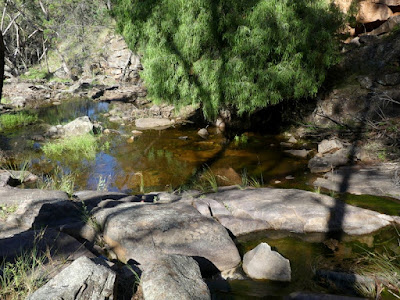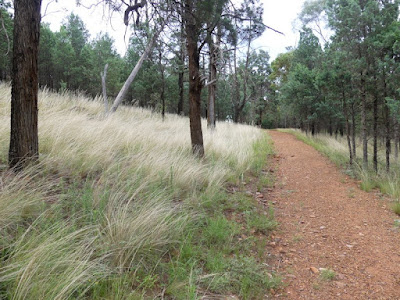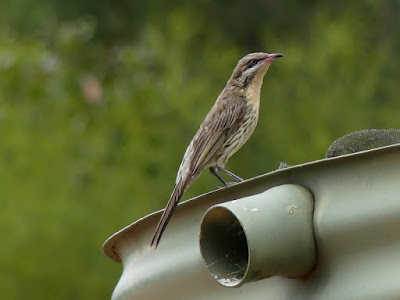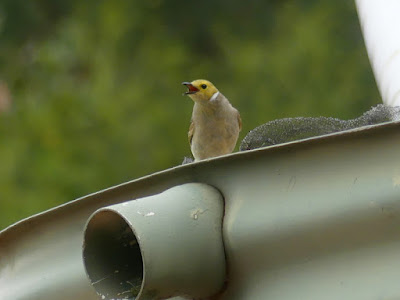We're very recently back from a short stay in one of our favourite parks, Cocoparra, some 400km to the west, in a
low range near the irrigation town of Griffith in the Riverina region. At this time of the year the coast is far too busy for our comfort, though we're heading there in a couple of weeks when the school holidays end. It's been a cool wet summer for the second year in a row, so we felt confident in heading inland to areas that are generally uncomfortably hot for camping at this time of year. It involves a half-day drive through the woodland remnants of the deep soils of the South-west Slopes
region to the edge of the great Western Plains, which effectively roll
flatly on until they reach the Indian Ocean, almost 3000km away.
This trip also marked our first in our new camper van, which we've been planning for years after many, many years of tenting, in acknowledgement of the passing years.

|
Above our camping set-up until now, and below the future!
Both photos are in the same campsite at Woolshed Flat Camp Ground at Cocoparra.
|
 |
The green on the ground under the trees in the background is testament
to the wet period - we are in the second year of a combined La Niña (which affects the Pacific)
and Negative Indian Ocean Dipole Events. The previous photo was taken during an extensive
drought which only ended in mid-2020.
|
 |
| Griffith (and Cocoparra) are at the end of the red arrow. |
This post is actually an updated and supplemented version of a post I wrote some years ago, during the drought, to offer contrasting faces of the park between wet and dry periods, both of which are quite natural here. And of course I have more photos to offer now. The average annual rainfall for the area is only 400mm anyway, and last time we stayed there, four years ago, there had only been 25mm in the previous three (hot) months. This time nearly 300mm had fallen in the last three months, and there were flowers and flowing streams.
When the sourly disposed
Surveyor-General John Oxley entered the land of the Wiradjuri people in
June 1817 he was, predictably, not impressed. Of the plains, which supported
rich though dry woodlands and mallee shrublands, he commented: “There is a
uniformity of barren desolation of this country which wearies one more
than I am able to express.” Of the view from the ridge of Cocoparra
(which he called Peel's Range) he opined: “I am the first white man to
see it, and I think I will be undoubtedly the last.” He continued that
theme when, to mark the king's birthday, they planted oak, apricot,
peach and quince seeds in the range (well, he was an surveyor, not a
horticulturalist) and he sniffed that the act was "to serve to
commemorate the day and situation, should these desolate plains be ever
again visited by civilised man of which, however, I think there is
little probability". Perhaps not someone you'd invite twice to dinner.
Civilised or not, Europeans
certainly did come and settle, albeit some 50 years later, taking up the
land surrounding the range as huge grazing properties, which were later
subdivided into wheat farms in the early 1900s. Meantime, not far to
the west, a massive irrigation scheme, planned in the late 19th century
and activated in the early years of the 20th, was transforming the
plains, bringing water from new distant reservoirs on the Murrumbidgee
River. The rich soils lacked only water, and with that they now produce
huge quantities of grapes, citrus, stone fruits, olives and vegetables. In fact on this trip we were somewhat taken aback to see that new vineyards have encroached right to the edge of the range at one point.
Fortunately for us, none of this affected the Cocoparra Range much;
there was some opportunistic grazing, but in general the slopes and
gorges were too rough for stock. In acknowledgement of this (plus, we
hope, because of the undoubted biodiversity values of the range) it was
declared a national park in 1969. It covers only
8300 hectares, though is supplemented by the 4600 hectare Cocoparra
Nature Reserve adjoining to the north (a nature reserve is dedicated
wholly to conservation and research, not passive recreation, which is a
function of national parks).
 |
| Welcome to Cocoparra National Park! |
 |
Looking west over the plains from Cocparra to the McPherson Range, at the foot of which lies Griffith.
Black Cypress Pine Callitris endlicheri dominates the foreground.
The two ranges comprise 350 million year old sandstones and other sedimentaries,
laid down on an inland floodplain. Folding and uplifting have raised the ranges
above the much newer soils which filled the basin between them. |
 |
Looking in the other direction, to the north-east from the highest point in the park,
Mount Bingar, a not-very-lofty 450 metres above sea level. This photo, from
our recent trip, certainly looks greener than the previous one, though this is
partly due to the Spearwood Wattles Acacia doratoxylon in the foreground.
|
The plants and resident animals of the park are quite capable of dealing with arid
conditions, but wet conditions bring flowers, ephemeral herbs and frogs calling in the gorges.
Firstly a quick general introduction to the park via the main vegetation types. As we
would expect, the vegetation on the hills is very different from that on
the lowest slopes and valleys. As seen in the first of the two vista photos above, Black
Cypress Pine is an important component on the hillsides and ridges.
 |
Black Cypress Pine along Jack's Track. This is one of our favourite walks in the park,
which starts on the exposed slopes and ends by descending
into the gorge sometimes known as Ladysmith Glen; several of the photos here were
taken on that walk. However on our most recent visit the upper section of the track was
closed for maintenance (perhaps unsurprising after 300 recent millimetres of rain!),
which was a double pity as there would have been good flowering up there.
|
 |
Currawang Acacia doratoxylon. This tall spindly wattle forms dense stands on ridges in particular.
It is also known as Spearwood Wattle, which is the meaning of the species name too. |
 |
Dwyer's Gum Eucalyptus dwyeri. One of the red gum group, which grows almost
exclusively in rocky situations. In particularly harsh positions it will grow as a mallee form -
ie a multi-stemmed shrub sprouting from a subterranean lignotuber. |
On the deeper soils different trees predominate.
 |
Mugga Ironbark Eucalyptus sideroxylon, with White Cypress Pine Callitris columellaris on the left.
The deeply fissured bark is impregnated with kino, and as it dries out becomes immensely hard.
There are a few dozen species with this characteristic scattered across eastern Australia. |
 |
Bimble Box Eucalyptus populneus. This lovely tree is characteristic of the NSW western plains, and
north into Queensland. The shiny rounded leaves give rise to the species name, meaning 'poplar-like'. |
And in the few creekbeds - which are dry most of the time - are found the ubiquitous
River Red Gums Eucalyptus camaldulensis, which dominate every stream line in inland Australia.
 |
River Red Gums along Jack's Creek Gorge (or Ladysmith Glen).
|
Contrast this with the same gorge (albeit not quite the same spot) four years ago.
And more of the gorge from January 2022, in a state I'd not it for years - a delight!
 |
| I'm sorry you can't hear the frogs calling. |
|
This is a lovely little gorge; we always pause at the lookouts above the gorge before descending - not this time of course, unfortunately, so not much 'lush' in these shots. However as a geologist might say, the less plant growth there is, the more you can appreciate the rocks! And I must say that sandstone is always a pleasure.
 |
| Looking down into Jacks Creek Gorge (Ladysmith Glen). |
 |
Looking across the gorge in another dry year, 2011.
|
 |
Cliffs in Jack's Creek Gorge again, 2011. The creepers tumbling down the faces are
Wonga Vine Pandorea pandorana, Family Bignoniaceae. I'll come back to them soon.
|
 |
And more sandstone, on another very pleasant creek walk, this time Store Creek,
a short drive south of Jack's Creek.
|
But back now to a few more plants before moving onto some of the animals of Cocparra, starting with the Wonga Vine.
 |
The lovely tube-shaped flowers of Wonga Vine. Remarkably, this species is found in most habitats
in all mainland Australian states, and beyond to New Guinea, Vanuatu and Indonesia. |
 |
Deane's Wattle Acacia deaneii flowering in Jack's Creek Gorge.
This is locally common in more sheltered areas of the park.
|
And unlike our most recent previous visits, herbs were abundant.
 |
Native grasses flowering under the Callitris along Store Creek walk, a delight to see.
|
 |
The gentle slopes around the camp ground were covered in swathes
of flowering daisies.
|
 |
Purple Burr-Daisies Calotis cuneifolia and Yellow Burr-Daisies C. lappulacea.
|
 |
Close-up of the Purple Burr-Daisies. Both species had been flowering for a while,
so there were lots of burrs (immensely prickly and clingy seed heads), a
great encouragement to stay on the tracks.
|
Which brings us to a few of the birds of Cocoparra; most of the following were taken around the camp ground.
 |
Bar-shouldered Dove Geopelia humeralis. The distinctive "let's go to schoooool" call
echoes around the camp, and the pretty doves are all around. I only saw them here
for the first time in 2018 (though I'm not there every year). This is a bird which seems
to be extending its range south along the coast, and increasingly inland.
|
There were actually five pigeon/dove species around camp, though I failed to get photos of Diamond Doves and probably didn't try for the Crested Pigeons, which are common at home too. Here are the other two, both common and familiar, but always welcome.
 |
Common Bronzewing Pigeon Phaps chalcoptera.
|
 |
Peaceful Dove Geopelia placida; their melodious 'toodle-oo' calls
were the sound track of the camp ground. This is not a very natural setting, but its current attraction
to birds is determined by the wet summer. There is a covered barbeque area,
with a tank filled by pipes from either side of the roof.
In the roof of the tank is a recess into which the pipes empty, covered
with a grill to stop leaves getting in. After so much rain the tank is completely full
and the birds were queuing up to drink from the 'well' at the top of it.
|
Apart from the doves, the main drinkers were honeyeaters, especially the ubiquitous Spiny-cheeked Honeyeaters Acanthagenys rufogularis.
 |
Spiny-cheeked Honeyeaters are very attractive dryland honeyeaters, quite large, with
pale salmon breast and throat, black-tipped pink bill and blue eyes.
|
 |
White-plumed Honeyeaters Ptilotula penicillata are common wherever there is water, especially along
River Red Gum streamlines, which they can dominate.
|
Other honeyeaters were about, including a White-eared Honeyeater
Nesoptilotis leucotis which also came to drink, though I didn't catch it there.
 |
| White-eared Honeyeater gleaning insects above our camp. |
 |
Blue-faced Honeyeater Entomyzon cyanotis on the way out of camp; this is the only one I've
ever seen in the park. The greenish eyepatch (not bright blue) tells us that it's a young
bird so perhaps it was dispersing after fledging. They're commoner in the wetter
areas around Griffith.
|
Parrots, mainly the Ringnecks, which tend to replace rosellas in the dry country, are common around camp.
 |
Ringneck Parrots Barnardius zonarius, above and below, are constantly and noisily
present in the camp ground and along roadsides.
|
Blue-bonnets Northiella haematogaster are common along the perimeter roads, but I find them nervous and generally hard to photograph. Mulga Parrots Psephotellus varius are less common and seemingly not always present - we didn't see them this time, though have in the past.
 |
Male Mulga Parrot Psephotellus varius, one of our loveliest parrots (in my opinion at least!)
and found throughout much of Australia's drylands.
|
One of the highlights of this trip, which I didn't catch with the camera, was a pair of Threatened Glossy Black-Cockatoos Calyptorhynchus lathami which flew low overhead one morning as I was making the tea.
Here are some other campground birds from various trips.
 |
Jacky Winter Microeca fascinans, one of the fly-catching Australian robins,
though without the distinctive colours of most of their family.
|
 |
White-browed Babbler Pomatostomus superciliosus, the smallest of the four Australian babblers
(there is also one in New Guinea). (More on them here.) I love these bold raucous highly sociable larrikins bouncing across the ground and making it clear just whose campground it is!
|
 |
Speckled Warbler Pyrrholaemus sagittatus, in Deane's Wattle Acacia deanei.
|
 |
Wedge-tailed Eagle Aquila audax; this beauty was perched by the road as we drove
out of camp one morning. |
And some other animals. There were four species of kangaroos around the camp - Eastern and Western Greys, Red-necked Wallabies and Euros. Only the Eastern Greys were actually in the campground.
 |
Euros Macropus robustus are stocky hill kangaroos found right acrosss
the country.
|
 |
Eastern Bearded Dragon Pogona barbata catching the late afternoon sun on a track, and
confident that we hadn't seen it. This is a familiar big lizard, found in a broad band of country
inland from the coast across south-eastern Australia.
|
 |
Male Wandering Ringtail damselfly Austrolestes leda (thanks Harvey)
attracted to the ephemeral pools in Jack's Creek Gorge.
|
 |
An impressive robber fly, Blepharotes sp. (thanks Kimberi) and maybe B. coriarius (thanks Harvey),
Family Asilidae that hung around our camp.
In flight it had a striking bright orange back, but not visible here.
|
 |
Striped Carrion Fly Oxysarcodexia varia (again I'm almost certain); possibly an unfortunate name
for PR purposes, but it's a pretty snappy little creature.
|
 |
Orange Spider Wasp Cryptocheilus bicolor hunting for spiders to paralyse,
in order to feed her larvae from eggs laid on it in a burrow.
(This wasp normally has a black abdomen with two orange stripes, but it seems that
it can sometimes be all orange. As ever, I claim no expertise here.)
|
At night Owlet-nighjars and Tawny Frogmouths call, and the rising moon and stars shine through the Bimble Box and the Southern Cross rides above. Who'd want to be anywhere else? As with all NSW parks now, you must book a campsite in advance on line, though it's free. Only six campers at a time are permitted so you'll not ever be crowded. You won't be sorry you went.



NEXT POSTING THURSDAY 3 MARCH
I
love to receive your comments and in future will be notifying you
personally by email when a new posting appears, if you'd like me to. All
current subscribers have been added to this mailing list and have
already been contacted.
This will mean one email every three weeks at the current rate of posting. I promise never to use the list for any other purpose and will never share it.
Should you wish to be added to it, just send me an email at calochilus51@internode.on.net.
You can ask to be removed from the list at any time,
or could simply mark an email as Spam, so you won't see future ones.
Thank you!

















































2 comments:
Hi Ian, Enjoyed both these posts. Don't know Cocoparra National Park at all. Another one to add the the ever-increasing list (if we ever go touring again). And, Mutawintji - a visit long ago, but well-remembered. Thanks for sparking some good memories.
I do love the white-browed babblers around camp sites.
Hi Deb and thanks for your comments. No reason really not to go somewhere like Cocoparra I think - if you don't want to you needn't encounter anyone en route, certainly no more than a normal visit to a shop or cafe. Once there you're pretty much guaranteed of solitude! And yes, babblers are one of my favourite neighbours.
Post a Comment